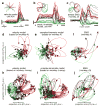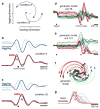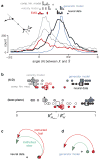Neural population dynamics during reaching
- PMID: 22722855
- PMCID: PMC3393826
- DOI: 10.1038/nature11129
Neural population dynamics during reaching
Abstract
Most theories of motor cortex have assumed that neural activity represents movement parameters. This view derives from what is known about primary visual cortex, where neural activity represents patterns of light. Yet it is unclear how well the analogy between motor and visual cortex holds. Single-neuron responses in motor cortex are complex, and there is marked disagreement regarding which movement parameters are represented. A better analogy might be with other motor systems, where a common principle is rhythmic neural activity. Here we find that motor cortex responses during reaching contain a brief but strong oscillatory component, something quite unexpected for a non-periodic behaviour. Oscillation amplitude and phase followed naturally from the preparatory state, suggesting a mechanistic role for preparatory neural activity. These results demonstrate an unexpected yet surprisingly simple structure in the population response. This underlying structure explains many of the confusing features of individual neural responses.
Conflict of interest statement
The authors declare no competing financial interests.
Figures






References
-
- Evarts EV. Relation of pyramidal tract activity to force exerted during voluntary movement. J Neurophysiol. 1968;31:14–27. - PubMed
-
- Mussa-Ivaldi FA. Do neurons in the motor cortex encode movement direction? An alternative hypothesis. Neurosci Lett. 1988;91:106–111. - PubMed
-
- Fetz EE. Are movement parameters recognizably coded in the activity of single neurons? Behavioral and Brain Sciences. 1992;15:679–690.
-
- Sanger TD. Theoretical considerations for the analysis of population coding in motor cortex. Neural Computation. 1994;6:29–37.
Publication types
MeSH terms
Grants and funding
LinkOut - more resources
Full Text Sources
Other Literature Sources

